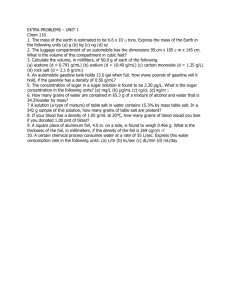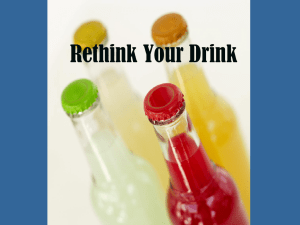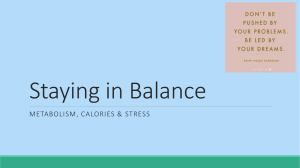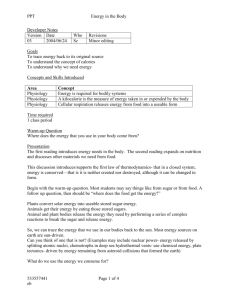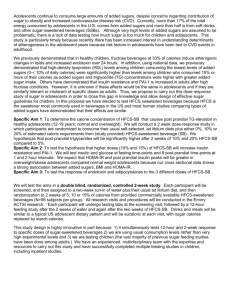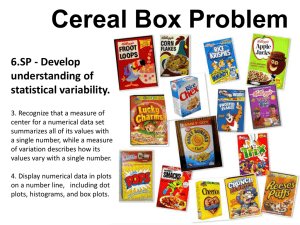Beverage Companies Attempt to Maintain Sales in the US and
advertisement
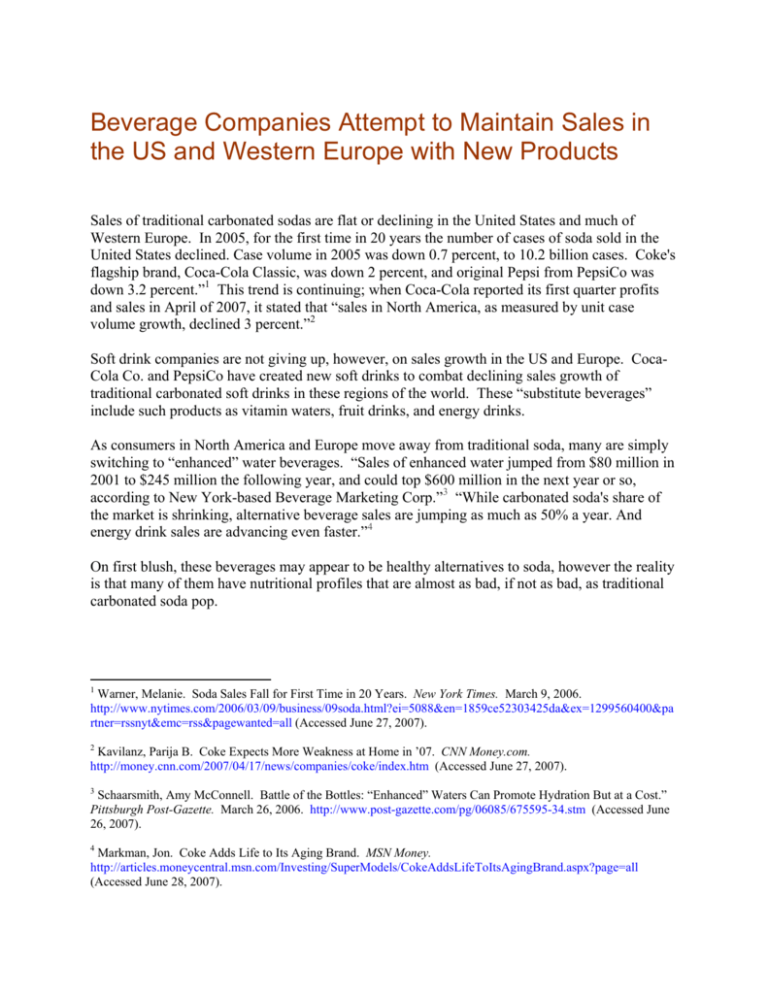
Beverage Companies Attempt to Maintain Sales in the US and Western Europe with New Products Sales of traditional carbonated sodas are flat or declining in the United States and much of Western Europe. In 2005, for the first time in 20 years the number of cases of soda sold in the United States declined. Case volume in 2005 was down 0.7 percent, to 10.2 billion cases. Coke's flagship brand, Coca-Cola Classic, was down 2 percent, and original Pepsi from PepsiCo was down 3.2 percent.”1 This trend is continuing; when Coca-Cola reported its first quarter profits and sales in April of 2007, it stated that “sales in North America, as measured by unit case volume growth, declined 3 percent.”2 Soft drink companies are not giving up, however, on sales growth in the US and Europe. CocaCola Co. and PepsiCo have created new soft drinks to combat declining sales growth of traditional carbonated soft drinks in these regions of the world. These “substitute beverages” include such products as vitamin waters, fruit drinks, and energy drinks. As consumers in North America and Europe move away from traditional soda, many are simply switching to “enhanced” water beverages. “Sales of enhanced water jumped from $80 million in 2001 to $245 million the following year, and could top $600 million in the next year or so, according to New York-based Beverage Marketing Corp.”3 “While carbonated soda's share of the market is shrinking, alternative beverage sales are jumping as much as 50% a year. And energy drink sales are advancing even faster.”4 On first blush, these beverages may appear to be healthy alternatives to soda, however the reality is that many of them have nutritional profiles that are almost as bad, if not as bad, as traditional carbonated soda pop. 1 Warner, Melanie. Soda Sales Fall for First Time in 20 Years. New York Times. March 9, 2006. http://www.nytimes.com/2006/03/09/business/09soda.html?ei=5088&en=1859ce52303425da&ex=1299560400&pa rtner=rssnyt&emc=rss&pagewanted=all (Accessed June 27, 2007). 2 Kavilanz, Parija B. Coke Expects More Weakness at Home in ’07. CNN Money.com. http://money.cnn.com/2007/04/17/news/companies/coke/index.htm (Accessed June 27, 2007). 3 Schaarsmith, Amy McConnell. Battle of the Bottles: “Enhanced” Waters Can Promote Hydration But at a Cost.” Pittsburgh Post-Gazette. March 26, 2006. http://www.post-gazette.com/pg/06085/675595-34.stm (Accessed June 26, 2007). 4 Markman, Jon. Coke Adds Life to Its Aging Brand. MSN Money. http://articles.moneycentral.msn.com/Investing/SuperModels/CokeAddsLifeToItsAgingBrand.aspx?page=all (Accessed June 28, 2007). For example, a 12 ounce can of Coke has approximately 140 calories and 39 grams of sugar.5 As depicted in the following charts, many of these substitute beverages contain similar amounts of sugar, if not more.6 The trend towards replacing carbonated soda pop with energy drinks, sweetened vitamin waters, and diluted juice drinks is of concern. A 2007 US National Academy of Sciences report recommended that soft drinks (caloric or non-caloric, carbonated or not) not be sold in schools during the normal school day.7 Here is how the soft drink industry is combating progress made in the US and Europe and scheming to keep consumers hooked on high calorie soft drinks. The Coca-Cola Company • Odwalla In 2001, Coca-Cola Inc. bought Odwalla, “a strong and growing player in the premium juices business.”8 Odwalla offers several beverage ranges, including juices, smoothies, and enhanced water beverages.9 In the years since Coca-Cola Co. purchased Odwalla, the brand has experienced considerable growth in sales, “growing sales by 50% over the past five years, despite little attention to marketing.”10 Odwalla is positioned as a more nutritious and healthy beverage option. In fact, its President, Shawn Sugarman, recently told GreenMoney Journal that “I think everybody is now chasing nourishment. Obesity and its related health problems are a huge concern for anybody in the food business today. On the food side, Odwalla is a great way to get healthy calories and 5 United States Government Indian Health Services. Healthy Beverages Community Action Kit. http://www.ihs.gov/MedicalPrograms/Diabetes/resources/HealthyBevToolKit06_yyfd.pdf (Accessed June 27, 2007). 6 A single serving can of Coca-Cola or Pepsi is 12 ounces. A single serving of many of these substitute beverages is 8 ounces, served in a bottle that contains 2.5 servings. Typically, these beverages are consumed as if the entire bottle contained one serving. These company’s serving sizes are arbitrary and unrealistic, so comparisons made between products will be on a per bottle or can basis, meaning that the nutrition profile of one can of soda will be compared to the nutrition profile of one can or bottle of a substitute beverage. This level of comparison more accurately reflects the consumption patterns of these beverages. 7 Nutrition Standards for Foods in Schools: Leading the Way Toward Healthier Youth. Authors: Committee on Nutrition Standards for Foods in Schools, Virginia A. Stallings and Ann L. Yaktine, editors; National Academies Press, 2007 8 Marino-Nachison, Dave. Coke Swallows Odwalla. October, 30, 2001. http://www.fool.com/news/foolplate/2001/foolplate011030.htm (Accessed June 7, 2007). 9 Odwalla. http://www.odwalla.com/product1.asp?p=h2odwalla&sw=1 (Accessed June 11, 2007). Brandweek. A Journey in Every Bottle. February 22, 2006. http://www.brandweek.com/bw/news/spotlight/article_display.jsp?vnu_content_id=1002073440 (Accessed June 27, 2007). 10 nourishment.”11 Unfortunately for the consumers who purchase Odwalla in search of a less calorie laden beverage than traditional soda, many of the beverages in the Odwalla line have as many, if not more, calories and grams of sugar than a 12 ounce can of Coke (140 calories, 39 grams of sugar), as illustrated by the following chart: Odwalla Nutrition Information12 Product Name Calories per 16 oz. Grams of Sugar per Bottle 16 oz. Bottle (2 servings) (2 servings) Strawberry Banana Fruit 260 calories 52 grams of sugar Smoothie Blend PomaGrand Juice 100% 320 calories 62 grams of sugar Juice AntioxiDance Cherry180 calories 46 grams of sugar Orange-Passionfruit Fruit Juice Drink Blend Superfood Micronutrient 260 calories 50 grams of sugar Fruit Juice Drink Blueberry Tea 120 calories 27 grams of sugar (Replenishment to Defend) • Glacéau In May of 2007, Coca-Cola Inc. “agreed to buy Vitamin Water maker Glacéau in a cash deal valued at $4.1 billion.”13 Glacéau manufacturers the brands Vitamin Water, Fruit Water, SmartWater and Vitamin Energy. The brand was an attractive acquisition for Coca-Cola Inc. because “of its position in the enhanced water and energy drink categories, which Coca-Cola is betting will make up a large portion of the beverage industry's growth in North America through 2010.”14 The belief that enhanced water and energy drinks will drive the growth of the beverage market in the United States in the coming years is reflected in Vitamin Water’s distribution and promotional efforts, which have centered on the United States market. According to its website, Vitamin Water has “really just scratched the surface in terms of distribution in the United States 11 Hoffman, Steve. GreenMoney Interview: Does Odwalla Go Better with Coke? An Interview with Odwalla President Shawn Sugarman. GreenMoney Journal. Summer 2007. http://www.greenmoneyjournal.com/article.mpl?newsletterid=27&articleid=278 (Accessed June 25, 2007). 12 Odwalla. http://www.odwalla.com/product.asp?p=beverages (Accessed July 31, 2007). Fox News. Coca-Cola Agrees to Buy Vitamin Water Maker Glacéau for $4.1B.” http://www.foxnews.com/story/0,2933,275386,00.html (Accessed June 27, 2007). 13 14 Ibid. and our focus remains here.”15 This is consistent with Coca-Cola’s efforts to expand its market share in the United States, where sales of traditional sodas have declined in recent years. Glacéau aggressively markets itself as a healthy alternative to soda. Its website boasts that “our products are inspired by nature and enhanced through science so they hydrate you with something truly good for your body (unlike all the garbage you’ve been drinking that you thought was good for you).”16 Additionally, in response to the question “What is Glacéau’s mission statement?” the brand pledges that “glacéau’s mission is to provide you with responsible hydration options that are natural, free of sodium, artificial sweeteners, chemical preservatives and other ingredients that are hard to pronounce.”17 Despite the company’s pledge of being committed to providing hydration options that are “truly good for your body,” the following table demonstrates that the calories and grams of sugar in one bottle of many of its products are only nominally less than the 140 calories and 39 grams of sugar found in a 12 ounce can of Coke. Glacéau Vitamin Water Nutrition Information18 Product Calories per 20 oz bottle Grams of sugar per 20 oz. (2.5 servings) bottle (2.5 servings) charge 125 calories 33 grams of sugar xxx (triple antioxidants) 125 calories 33 grams of sugar formula 50 125 calories 33 grams of sugar defense 125 calories 33 grams of sugar vital-t 125 calories 33 grams of sugar endurance peach mango 125 calories 33 grams of sugar balance cran-grapefruit 125 calories 30 grams of sugar energy tropical citrus 100 calories 20 grams of sugar essential orange-orange 100 calories 20 grams of sugar multi-v lemonade 100 calories 20 grams of sugar power-c dragonfruit 100 calories 20 grams of sugar rescue green tea 100 calories 20 grams of sugar revive fruit punch 125 calories 30 grams of sugar 15 Vitamin Water. http://www.vitaminwater.com (Accessed June 22, 2007). 16 Vitamin Water. http://www.vitaminwater.com (Accessed June 22, 2007). 17 Ibid. Bevnet.com. Glacéau Vitamin Water – Nutrition Facts & Ingredients, BevNET.com Review. http://www.bevnet.com/reviews/glaceauvitamin/facts.asp (Accessed June 25, 2007). 18 • Fuze Fuze was a small beverage company that launched its first drinks in 2001. In the years since, it has experienced considerable sales growth. It is marketed as an “alternative non-carb beverage – a drink which contains no high fructose corn syrup and has real health benefits – that tastes great, looks great, and is great for you.”19 In 2004, “Fuze sold nearly 50 million bottles in the US and began to sell product in Asia, South America and Europe.”20 Just three years later, the brand was purchased by Coca-Cola Co. as part of Coke’s efforts to expand its beverage offerings beyond traditional soda and increase its profitability in North America. “Fuze beverages may help CocaCola win back customers who switched from sweetened sodas to drinks such as PepsiCo’s SoBe tea.”21 However, like many other substitute beverages that are sold to consumers as healthy alternatives to soda, many products in the Fuze product line have about the same amount of calories and sugar as a can of Coke. If consumers are not consciously reading the labels of the varied beverages sold by Fuze, they could easily find themselves about the same, if not a greater, amount of calories and sugar than they would consume from drinking a can of Coke. Product Name Refresh Your Soul with Strawberry Banana Green Tea Revitalize Yourself with Blackberry Grape Revitalize Yourself with Orange Mango Fuze Nutrition Information22 Calories per 16 oz. Bottle (2 servings) 200 calories Grams of Sugar per 16 oz. Bottle (2 servings) 48 grams of sugar 120 calories 200 calories 32 grams of sugar 50 grams of sugar 200 calories 50 grams of sugar PepsiCo • SoBe PepsiCo purchased SoBe in 2000. In 2003, SoBe launched its Synergy line, which was marketed as “a new range of ‘healthy refreshment beverages.’”23 The new line was designed for vending 19 Fuze Beverages. http://www.drinkfuze.com/ (Accessed June 29, 2007). 20 Ibid. 21 Coca-Cola to Buy Fuze Beverage. New York Times. February 2, 2007. http://www.nytimes.com/2007/02/02/business/02drink.html?ex=1183262400&en=a1ed7fa52b149be2&ei=5070 (Accessed June 29, 2007). 22 Fuze Beverages. http://www.drinkfuze.com/ (Accessed June 13, 2007). machines, and its launch was “timed to respond to growing criticism of the soft drinks industry, particularly those brands available in vending machines in schools, which are thought to be contributing to the rising rates of obesity among children. ‘In recent months, the beverage industry as a whole has been challenged to develop a wider array of ‘better-for-you’ products,’ said SoBe chief operating officer Tom Bene.”24 However, Synergy drinks contain a considerable amount of calories and sugar. As illustrated by the following chart listing sugar and calorie contents, SoBe Synergy beverages do not offer the “healthy refreshment beverage” the company promises to provide consumers. Product Name Elixir 3C Pomegranate-Cranberry Courage Cherry Citrus Flavored Beverage Lifewater Strawberry Kiwi Essential Energy Berry Pomegranate Adrenaline Rush Synergy Fruit Punch No Fear SoBe Nutrition Information25 Calories per 20 oz. Bottle (2.5 servings) 250 calories 280 calories 100 calories 230 calories (per 16 oz. can) 140 calories (per 8.3 oz. can) 120 calories (per 11.5 oz. can) 260 calories (16 oz. can) Grams of Sugar per 20 oz. Bottle (2.5 servings) 63 grams of sugar 75 grams of sugar 24 grams of sugar 59 grams of sugar (per 16 oz. can) 25 grams of sugar (per 8.3 oz. can) 28 grams of sugar (per 11.5 oz. can) 66 grams of sugar (per 16 oz. can) Cadbury Schweppes • Snapple Cadbury Schweppes, maker of “7-Up” has recently abandoned much of its efforts to sell that product around the world, and instead has decided to focus its growth efforts on promoting soft drink substitutes for the U.S. market. The company purchased Snapple, a line of diluted fruit flavored beverages and teas, as part of that strategy. With a slogan of “Made From the Best Stuff on Earth,” Snapple clearly positions itself as an alternative to traditional sodas. The company’s 23 SoBe Launches Synergy Line. June 10, 2003. http://www.nutraingredients-usa.com/news/ng.asp?id=25200sobe-launches-synergy (Accessed June 29, 2007). 24 25 Ibid. SoBe Beverage Universe. http://www.sobebev.com/product_info (Accessed June 13, 2007). website touts its “world of authentic Good for You Teas”26 in a effort to appeal to more health conscious consumers. Consumers who drink Snapple tea and fruit flavored beverages as a more healthful alternative to carbonated soft drinks, would be disappointed to learn that the amounts of sugar and calories per bottle are considerably more than the amounts found in a 12 oz can of Coke or Pepsi. Product Name Snapricot Orange Mango Madness Peach Tea Raspberry Tea White Tea Snapple Nutrition Information27 Calories per 16 oz. Bottle (2 servings) 240 calories 220 calories 200 calories 200 calories 120 calories Grams of Sugar per 16 oz. Bottle (2 servings) 56 grams of sugar 54 grams of sugar 48 grams of sugar 50 grams of sugar 30 grams of sugar In sum, while sales of traditional carbonated soft drinks in the US and Europe are flat, or decreasing, companies have developed new products in an attempt to maintain overall sales growth. Unfortunately, many of these new products are no healthier than traditional sodas. 26 Snapple. http://www.snapple.com/index.html (Accessed July 25, 2007). 27 Snapple. http://www.snapple.com/index.asp?Pageid=1&subid=1&contentid=1 (Accessed June 12, 2007).
